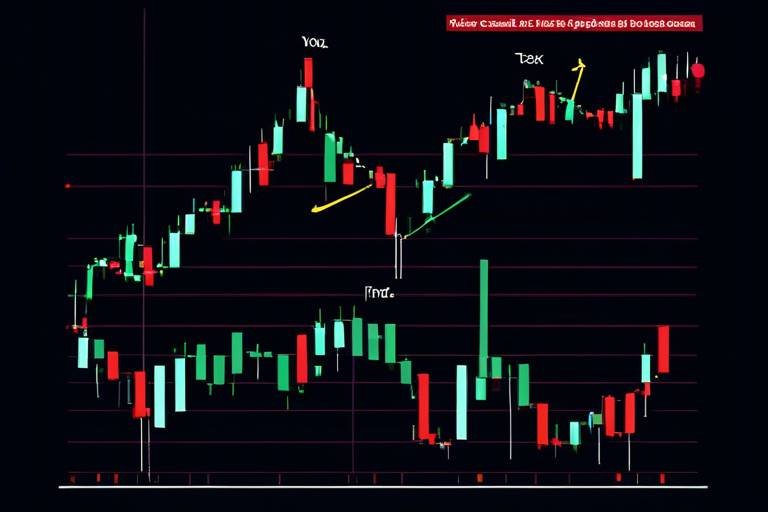How to Develop a Risk-Reward Ratio for Trading
This article explores the essential components of creating a risk-reward ratio for trading, helping traders make informed decisions and manage their investments effectively.
The risk-reward ratio is a critical concept in trading that quantifies the potential profit against the potential loss. Understanding this ratio helps traders evaluate the viability of their trades. To put it simply, if you're considering a trade, you need to ask yourself: "Is the potential reward worth the risk I'm taking?" This question forms the backbone of your trading strategy and can mean the difference between success and failure in the market.
Calculating the risk-reward ratio involves simple mathematical formulas. This section provides step-by-step guidance on how to accurately determine your ratio for each trade. The formula is quite straightforward:
| Formula | Description |
|---|---|
| Risk-Reward Ratio (Potential Profit) / (Potential Loss) | This formula helps you understand how much you stand to gain compared to how much you could potentially lose. |
For example, if you're risking $100 to make a profit of $300, your risk-reward ratio would be 1:3. This means for every dollar you risk, you stand to gain three. A good rule of thumb is to aim for a ratio of at least 1:2, but the higher, the better!
To calculate the risk-reward ratio, identifying clear entry and exit points is essential. You can think of these points as the launch pad and the finish line of your trading journey. Without a clear entry point, you might find yourself jumping into trades haphazardly, which can lead to poor outcomes. Similarly, exit points help you lock in profits or cut losses. Here are a few strategies to pinpoint these critical levels:
- Technical Analysis: Use charts and indicators to identify support and resistance levels.
- Market Sentiment: Gauge the mood of the market to determine optimal entry and exit points.
- News Events: Be aware of upcoming news that may impact your trades.
Stop-loss orders are vital for managing risk. This section explains how to effectively set stop-loss levels to protect your capital while maintaining a favorable risk-reward ratio. A stop-loss is like a safety net; it prevents you from falling too deep into the abyss of losses. By setting a stop-loss, you determine the maximum amount of money you’re willing to lose on a trade, allowing you to trade with confidence.
Setting realistic profit targets is crucial for achieving a good risk-reward ratio. Here, we explore how to establish achievable profit goals based on market conditions. Think of profit targets as your destination on a road trip; without a clear destination, you might wander aimlessly. Factors to consider when setting profit targets include market volatility, historical price movements, and your trading style.
Market conditions can change rapidly, necessitating adjustments to your risk-reward ratio. This part discusses how to adapt your strategy to maintain an effective risk-reward balance. Just like a seasoned sailor adjusts their sails to the winds, you too must be flexible. If the market becomes more volatile, you might need to widen your stop-loss or adjust your profit targets. It's all about staying ahead of the curve!
Many traders make mistakes when calculating their risk-reward ratio. This section highlights common pitfalls and offers tips on how to avoid them for better trading outcomes. Remember, trading is as much about psychology as it is about numbers.
Traders often overestimate potential gains, leading to poor risk-reward ratios. This subheading examines the importance of realistic expectations in trading strategies. It's easy to get caught up in the excitement of potential profits, but staying grounded is key. Always ask yourself: "Is this target realistic?"
Ignoring market volatility can skew your risk-reward ratio. This section emphasizes the need to factor in volatility when developing your trading plan. Volatility is like the weather; it can change unexpectedly. By considering volatility, you can better prepare for potential fluctuations in your trades.
Q: What is a good risk-reward ratio?
A: Generally, a risk-reward ratio of 1:2 or higher is considered good. This means for every dollar you risk, you aim to earn at least two.
Q: How often should I adjust my risk-reward ratio?
A: You should adjust your ratio as market conditions change. Stay alert and be ready to adapt your strategy.
Q: Can I trade without a risk-reward ratio?
A: While it's possible, trading without a risk-reward ratio is risky and not advisable. It’s a fundamental part of a sound trading strategy.

Understanding Risk-Reward Ratio
The risk-reward ratio is a fundamental concept that every trader should grasp to enhance their trading strategy. Simply put, it measures the potential profit of a trade against the potential loss. This ratio is not just a number; it's a vital tool that can guide traders in making informed decisions. Think of it as a safety net that helps you navigate the unpredictable waters of the financial markets. Understanding this ratio allows you to evaluate whether a trade is worth taking, based on the risks involved.
Imagine you’re standing at a crossroads, and on one path, you see a potential profit of $300, while the other path shows a possible loss of $100. In this scenario, the risk-reward ratio would be calculated as follows:
| Potential Profit | Potential Loss | Risk-Reward Ratio |
|---|---|---|
| $300 | $100 | 3:1 |
This means for every dollar you risk, you stand to gain three. A ratio of 3:1 is generally considered favorable, as it suggests that the potential reward significantly outweighs the risk. However, it's crucial to remember that a good risk-reward ratio alone doesn't guarantee success in trading. It must be combined with sound market analysis and a solid trading plan.
Traders often use various strategies to determine their risk-reward ratios. Some might rely on historical data, while others look at current market trends. Regardless of the approach, the key is to remain consistent and realistic. For instance, if you frequently find yourself in trades with a 1:1 ratio, where your potential profit equals your potential loss, you might want to reconsider your strategy. After all, the goal is to maximize profits while minimizing losses.
Furthermore, the risk-reward ratio is not static; it can change based on market conditions. As a trader, you should be prepared to adjust your ratios as needed. This flexibility can be the difference between a successful trade and a costly mistake. By keeping an eye on market trends and being willing to adapt, you can maintain a favorable risk-reward balance.
In conclusion, understanding the risk-reward ratio is essential for any trader looking to navigate the complex world of trading. It provides a framework for evaluating trades and helps in making informed decisions. Remember, the key lies in balancing risk with potential reward, and consistently applying this knowledge to your trading strategy.

Calculating the Ratio
When it comes to trading, understanding how to calculate the risk-reward ratio is essential for making informed decisions. This ratio helps traders assess the potential profit of a trade compared to the potential loss they might incur. The formula is relatively straightforward, but it requires a careful approach to ensure accuracy. To calculate your risk-reward ratio, you can follow these simple steps:
- Identify Your Entry Point: This is the price at which you plan to enter the trade. It’s crucial to be precise here, as it sets the foundation for your calculations.
- Determine Your Stop-Loss Level: This is the price at which you will exit the trade if it goes against you. The distance between your entry point and stop-loss level represents your potential loss.
- Set Your Profit Target: This is the price at which you plan to exit the trade if it moves in your favor. The distance between your entry point and profit target represents your potential gain.
Once you have these three key points, you can use the following formula to calculate the risk-reward ratio:
Risk-Reward Ratio (Potential Profit) / (Potential Loss)
To illustrate this with an example, let’s say you plan to enter a trade at $100, set your stop-loss at $90, and your profit target at $120. Here’s how you would calculate it:
| Parameter | Value |
|---|---|
| Entry Price | $100 |
| Stop-Loss Price | $90 |
| Profit Target Price | $120 |
| Potential Loss | $100 - $90 $10 |
| Potential Profit | $120 - $100 $20 |
| Risk-Reward Ratio | $20 / $10 2:1 |
This means that for every dollar you risk, you stand to gain two dollars. A risk-reward ratio of 2:1 is generally considered favorable, as it indicates that the potential reward outweighs the risk involved. However, it’s important to remember that a good risk-reward ratio alone doesn’t guarantee success; it must be combined with a solid trading strategy and sound market analysis.
Moreover, as market conditions fluctuate, you may need to adjust your entry and exit points, which in turn will affect your risk-reward ratio. Staying adaptable and continuously reassessing your positions is key to successful trading. Remember, the goal is not just to chase profits but to manage risk effectively while maximizing potential gains.
- What is a good risk-reward ratio? A ratio of 2:1 or higher is often recommended, as it indicates that potential gains significantly outweigh potential losses.
- How often should I recalculate my risk-reward ratio? It’s wise to recalculate your ratio whenever you adjust your entry or exit points or when market conditions change.
- Can I use the risk-reward ratio for all types of trading? Yes, the risk-reward ratio is applicable in various trading styles, including day trading, swing trading, and long-term investing.

Identifying Entry and Exit Points
When it comes to trading, identifying entry and exit points is like finding the right moment to jump on a roller coaster—it can make all the difference between a thrilling ride and a heart-stopping drop. These points are crucial for establishing a solid risk-reward ratio, as they determine where you will enter the market and where you will take your profits or cut your losses. But how do you pinpoint these critical levels? Let's dive into some strategies that can help you navigate this essential aspect of trading.
Firstly, one effective method for identifying entry points is through the use of technical analysis. This involves studying price charts and indicators to understand market trends. Look for patterns such as support and resistance levels, which can act as indicators of potential entry points. For example, if a stock consistently bounces off a certain price level, that could be a strong indication that it's a good entry point. On the flip side, if it struggles to break through a certain price, that might represent a solid exit point.
Another useful tool in your trading arsenal is the moving average. By calculating the average price of an asset over a specific period, you can get a clearer picture of its trend. When the price crosses above the moving average, it might signal a good entry point, while a cross below could indicate an exit point. This method is particularly effective in trending markets, where prices tend to move in one direction for an extended period.
Moreover, don't forget the importance of fundamental analysis. This approach involves evaluating a company's financial health, industry position, and economic conditions to determine its potential for growth. For instance, if you're trading stocks and discover that a company is about to release an innovative product, it could be a perfect opportunity to enter the market. Conversely, if there are signs of economic downturns or negative news about the company, it might be wise to exit before the price drops.
To keep your strategy organized, consider creating a simple table to track your entry and exit points along with the rationale behind each decision. Here's a quick example:
| Trade | Entry Point | Exit Point | Rationale |
|---|---|---|---|
| Stock A | $50 | $70 | Strong support level and positive earnings report |
| Stock B | $30 | $25 | Market downturn and negative news |
Finally, always remember that risk management plays a significant role in identifying these points. Setting clear stop-loss orders will help you minimize losses if the market takes an unexpected turn. It's like having a safety net; it won't prevent you from falling, but it will cushion the impact. By establishing your entry and exit points with a solid plan, you can navigate the trading landscape with greater confidence, ensuring that your risk-reward ratio remains favorable.
- What is the best way to determine entry and exit points? The best way is to combine technical analysis, fundamental analysis, and market sentiment to make informed decisions.
- How often should I adjust my entry and exit points? You should adjust them based on changing market conditions, new information, and your trading strategy.
- Can I use automated tools to help identify these points? Yes, many traders use trading software that analyzes data and suggests potential entry and exit points based on predefined criteria.

Setting Stop-Loss Orders
Setting stop-loss orders is a crucial step in managing your trading risk effectively. Think of a stop-loss order as your safety net; it’s there to catch you when things go wrong. By defining a specific price level at which your trade will automatically close, you can protect your capital from significant losses. But how do you determine the right level for your stop-loss? It’s not just about picking a number; it requires careful consideration of various factors.
First and foremost, you need to analyze the market conditions and the specific asset you are trading. For instance, if you’re trading a highly volatile stock, you might want to set your stop-loss further away from your entry point to avoid being stopped out prematurely. Conversely, for a more stable asset, a tighter stop-loss might be appropriate. The idea is to find a balance that minimizes your risk while allowing for normal market fluctuations.
To illustrate this, let’s consider a scenario where you buy shares of a tech company at $100. If you decide that a stop-loss of 10% is acceptable, you would set your stop-loss order at $90. This means that if the stock price drops to $90, your position will automatically close, limiting your loss to $10 per share. However, if the stock is known for large price swings, you might want to set your stop-loss at $85 instead, giving it more room to breathe.
Another important aspect of setting stop-loss orders is to consider your overall trading strategy. Are you a day trader looking for quick profits, or a long-term investor? For day trading, tighter stop-losses are often used to protect against sudden price movements. On the other hand, long-term investors might opt for wider stop-losses to avoid the noise of daily fluctuations. It’s essential to align your stop-loss strategy with your trading style.
Additionally, you should always be prepared to adjust your stop-loss as your trade progresses. If the price moves in your favor, consider moving your stop-loss to break even or even into profit. This technique, known as a trailing stop, allows you to lock in profits while still protecting against potential losses. However, be cautious; moving your stop-loss too close can result in being stopped out unnecessarily.
In conclusion, setting stop-loss orders is not just a safety measure; it’s a fundamental aspect of a disciplined trading strategy. By carefully analyzing market conditions, aligning your stop-loss with your trading style, and being willing to adapt as your trade evolves, you can significantly improve your risk management and overall trading success.
Frequently Asked Questions
- What is a stop-loss order? A stop-loss order is an instruction to sell a security when it reaches a certain price, helping to limit losses.
- How do I determine the best stop-loss level? Consider the asset's volatility, your trading strategy, and the market conditions to set an appropriate stop-loss level.
- Can I adjust my stop-loss after placing it? Yes, you can modify your stop-loss order as the trade progresses to better protect your gains.

Determining Profit Targets
Setting realistic profit targets is crucial for achieving a good risk-reward ratio in trading. The journey to identifying these targets begins with a clear understanding of your trading strategy and the market environment. Think of profit targets as the destination on your trading map; without a clear destination, you may find yourself wandering aimlessly, which can lead to missed opportunities or unnecessary losses.
To determine your profit targets effectively, consider the following factors:
- Market Conditions: The current state of the market plays a significant role in setting achievable profit targets. Are you trading in a trending market or a ranging one? In trending markets, you might set your targets further away, while in a ranging market, closer targets could be more appropriate.
- Historical Data: Analyzing past price movements can provide valuable insights. Look at how far the price has moved in similar situations. This historical perspective can help you gauge realistic targets based on previous performance.
- Technical Indicators: Utilize technical analysis tools such as support and resistance levels, Fibonacci retracements, or moving averages to identify potential price levels where the market might reverse or stall. These indicators can serve as excellent reference points for your profit targets.
Once you’ve gathered this information, you can start formulating your profit targets. A common approach is to set your profit target at a level that is at least 1.5 to 2 times your risk. For example, if your stop-loss is set at 20 pips, consider setting your profit target at 30 to 40 pips. This ensures that even if you have a few losing trades, the winning trades can more than compensate for those losses.
However, it’s essential to remain flexible. The market is dynamic, and conditions can change rapidly. Therefore, continually reassess your profit targets and adjust them based on real-time market analysis. Think of it like navigating a ship; sometimes, you need to change course to reach your destination safely.
In summary, determining profit targets is not just about setting arbitrary numbers; it involves a careful analysis of market conditions, historical data, and technical indicators. By establishing well-thought-out profit targets, you can significantly enhance your trading strategy and improve your overall performance in the market.
- What is a good risk-reward ratio for trading? A commonly recommended risk-reward ratio is 1:2, meaning for every $1 risked, aim to make $2.
- How do I adjust my profit targets? Regularly review market conditions and adjust your targets based on technical analysis and price action.
- Can I use profit targets in all trading styles? Yes, profit targets can be applied in day trading, swing trading, and long-term investing, but the approach may vary.

Adjusting the Ratio
In the ever-evolving world of trading, one thing is certain: market conditions can change in the blink of an eye. This constant flux means that your risk-reward ratio shouldn't be set in stone. Instead, think of it as a living, breathing entity that requires regular adjustments to stay relevant and effective. Just like a ship navigating through turbulent waters, you must steer your trading strategy to adapt to the waves of market volatility.
When considering adjustments to your risk-reward ratio, it's essential to remain vigilant and responsive. Here are a few key factors to keep in mind:
- Market Trends: Always keep an eye on prevailing market trends. If the market shifts from bullish to bearish, or vice versa, it may be time to reevaluate your entry and exit points.
- Economic Indicators: Economic reports, such as employment figures or GDP growth, can significantly impact market sentiment. Adjust your ratio based on how these indicators may influence price movements.
- Technical Analysis: Utilize technical indicators like moving averages, RSI, or MACD to gauge market momentum. If these indicators suggest a change in direction, your risk-reward ratio may need recalibrating.
For instance, let’s say you initially set a risk-reward ratio of 1:3, where you're willing to risk $100 to potentially gain $300. However, if you notice that the market is becoming increasingly volatile, you might want to adjust your ratio to 1:2 instead. This adjustment allows you to be more conservative in your approach, ensuring that you protect your capital while still aiming for reasonable gains.
Moreover, don't forget to consider your own trading psychology. If you're feeling anxious or uncertain about a trade, it might be wise to tighten your stop-loss or lower your profit target. Remember, trading is not just about numbers; it's also about managing your emotions and making decisions that align with your risk tolerance.
In summary, adjusting your risk-reward ratio is crucial for maintaining a balanced trading strategy. By staying alert to market changes, leveraging technical analysis, and understanding your emotional state, you can ensure that your risk-reward ratio remains effective and aligned with your trading goals.
What is a good risk-reward ratio for trading?
A common guideline is to aim for a risk-reward ratio of at least 1:2. This means for every dollar you risk, you aim to make two dollars. However, this can vary based on your trading style and market conditions.
How often should I adjust my risk-reward ratio?
There’s no set rule, but you should consider adjusting your ratio whenever there are significant changes in market conditions, economic indicators, or your own trading psychology.
Can I use the same risk-reward ratio for all trades?
While it’s possible to have a standard ratio, it’s often beneficial to adjust it based on specific trade setups and market dynamics. Flexibility can lead to better trading outcomes.
What should I do if my trades consistently hit stop-losses?
If you find that your trades are frequently hitting stop-losses, it may be time to reevaluate your trading strategy, including your risk-reward ratio, entry and exit points, and overall market analysis.

Common Mistakes to Avoid
When diving into the world of trading, it's all too easy to stumble into pitfalls that can derail your success. Understanding and avoiding these common mistakes is crucial for developing an effective risk-reward ratio. It's like navigating through a dense forest; one wrong turn can lead you astray. So, let’s shine a light on some of these errors to help you stay on the right path.
One of the most prevalent mistakes traders make is overestimating potential gains. It's tempting to dream big and imagine hitting the jackpot with every trade, but this can lead to unrealistic expectations. When traders inflate their profit targets, they often ignore the true nature of the market. Instead of aiming for the stars, consider setting realistic and achievable goals. Think of it as aiming for a solid tree branch rather than reaching for the clouds—you’ll have a much better chance of success!
Another frequent misstep is neglecting market volatility. Volatility is like the unpredictable weather in a stormy season; it can change in an instant and affect your trading outcomes dramatically. Failing to account for this can skew your risk-reward ratio significantly. For example, if you’re trading a stock that has a history of wild price swings, you need to factor that into your calculations. Ignoring it is like sailing a ship without checking the forecast—you might end up capsizing! Always incorporate volatility into your trading plan to ensure that your risk-reward ratio remains realistic and effective.
Moreover, many traders tend to set their stop-loss orders too tight. This can lead to being stopped out of trades prematurely, especially in a volatile market where small fluctuations are common. Instead, give your trades some breathing room. A well-placed stop-loss can protect your capital without cutting off your potential for profit too soon. Think of it as allowing a plant to grow; if you keep trimming it back, it will never reach its full height.
Furthermore, failing to adjust your risk-reward ratio according to changing market conditions is another critical mistake. Markets are dynamic and can shift rapidly due to various factors such as economic news, geopolitical events, or even trader sentiment. Sticking rigidly to an initial ratio without reassessing can lead to missed opportunities or increased losses. It’s essential to stay flexible and ready to adapt your strategy as the market evolves. Like a seasoned dancer, you must be able to pivot and change your steps based on the rhythm of the music.
Lastly, one of the biggest traps is not keeping a trading journal. A journal serves as a mirror reflecting your trading decisions, outcomes, and the thought processes behind them. Without it, you might find yourself repeating the same mistakes over and over. Documenting your trades allows you to analyze what’s working and what’s not, enabling you to refine your approach over time. It’s like having a GPS system guiding you through the trading landscape, helping you avoid those pesky roadblocks.
In conclusion, avoiding these common mistakes can significantly enhance your trading strategy. By being aware of the pitfalls such as overestimating gains, neglecting volatility, setting tight stop-losses, failing to adjust your ratios, and not keeping a trading journal, you can navigate the trading world more effectively. Remember, trading is not just about making profits; it’s about making informed decisions that lead to sustainable success.
- What is a risk-reward ratio?
The risk-reward ratio is a measure that compares the potential profit of a trade to the potential loss, helping traders assess whether a trade is worth taking.
- How can I calculate my risk-reward ratio?
To calculate your risk-reward ratio, divide the amount you expect to gain from a trade by the amount you are willing to lose. For example, if you expect to gain $300 and are willing to risk $100, your ratio is 3:1.
- Why is it important to set stop-loss orders?
Stop-loss orders are crucial for managing risk. They help protect your capital by automatically closing a trade when it reaches a certain loss level, preventing further financial damage.
- How often should I review my trading strategy?
It’s wise to review your trading strategy regularly, ideally after every trade or at least weekly. This allows you to adjust based on performance and market conditions.

Overestimating Potential Gains
One of the most common pitfalls that traders face is the tendency to overestimate potential gains. It’s like dreaming of a big lottery win while ignoring the odds stacked against you. Many traders enter positions with the hope of achieving unrealistic profit margins, which can lead to disastrous outcomes. This overconfidence can stem from a variety of factors, including past successes, market hype, or simply a lack of understanding of the market dynamics at play.
When traders set their sights too high, they often ignore the fundamental principles of risk management. For instance, if a trader believes they can double their investment in a matter of days, they might overlook the necessary calculations to ensure that their risk-reward ratio remains favorable. This is where the danger lies—if the anticipated gains are not based on sound analysis, a trader may find themselves in a precarious position, risking significant losses.
To avoid falling into this trap, it's essential to establish realistic expectations based on thorough research and analysis. Here are a few strategies to help keep your expectations grounded:
- Conduct Thorough Market Research: Before entering a trade, analyze market trends, historical data, and news that could impact your asset. This will give you a clearer picture of what to expect.
- Set Achievable Profit Targets: Instead of aiming for the moon, set incremental profit targets that reflect the market's current conditions. This way, you can celebrate smaller victories without risking everything on a single trade.
- Utilize Technical Analysis: Use charts, indicators, and patterns to gauge realistic entry and exit points. This quantitative approach can help you make more informed decisions.
Moreover, it’s vital to remember that the market is inherently unpredictable. Just because a stock has performed well in the past doesn’t mean it will continue to do so. The volatility of the market can lead to sudden downturns, catching traders off guard. Therefore, maintaining a conservative approach and adjusting your expectations based on current market conditions is key to successful trading.
In conclusion, by managing your expectations and focusing on realistic gains, you can create a more sustainable trading strategy. This practice not only enhances your risk-reward ratio but also fosters a healthier relationship with the market. Remember, trading is a marathon, not a sprint. The goal is to develop a consistent, disciplined approach that leads to long-term success, rather than chasing after quick wins that could lead to significant losses.
- What is a risk-reward ratio?
The risk-reward ratio is a measure that compares the potential profit of a trade to its potential loss. A favorable ratio indicates that the potential gains outweigh the risks involved. - How can I calculate my risk-reward ratio?
To calculate your risk-reward ratio, divide the amount you expect to gain from a trade by the amount you are willing to lose. For example, if you expect to gain $200 and are willing to risk $100, your ratio would be 2:1. - Why is it important to set realistic profit targets?
Setting realistic profit targets helps you manage your expectations and reduces the likelihood of making impulsive decisions based on unrealistic hopes for profit. - How can market volatility affect my trading strategy?
Market volatility can lead to sudden price changes, which can impact your risk-reward ratio. It’s crucial to factor in volatility when planning your trades to avoid unexpected losses.

Neglecting Market Volatility
When it comes to trading, one of the biggest blunders you can make is . Picture this: you're on a roller coaster, and just as you think you're cruising smoothly, the ride takes a sudden dip. That’s how the market behaves! Volatility can shake up your trading plans faster than you can say "stop-loss." Understanding and incorporating volatility into your risk-reward ratio is not just smart; it's essential for survival in the trading game.
Market volatility refers to the degree of variation in trading prices over time. High volatility means prices can change dramatically in a short period, while low volatility indicates a more stable market. Failing to account for these fluctuations can lead to disastrous outcomes. For instance, if you set your profit targets without considering how erratic the market can be, you might find yourself chasing unrealistic gains, only to end up with losses instead.
To effectively integrate volatility into your risk-reward ratio, consider the following:
- Historical Volatility: Look at past price movements to gauge how much the market fluctuates. This will provide a baseline for what you can expect.
- Implied Volatility: This is derived from options pricing and can give you insights into market expectations for future volatility. High implied volatility often indicates that traders expect significant price movement.
- News Events: Major economic announcements, earnings reports, or political events can cause spikes in volatility. Always keep an eye on the economic calendar!
By factoring in these elements, you can set more realistic stop-loss orders and profit targets. For example, if you know that a particular stock tends to move 5% on average during earnings season, you should adjust your risk-reward ratio accordingly. Instead of aiming for a 10% profit target with a 2% stop-loss, you might want to consider a more balanced approach, like a 5% profit target with a 1% stop-loss. This way, you’re not just throwing darts in the dark!
In summary, neglecting market volatility can skew your risk-reward ratio and lead to poor trading decisions. By acknowledging the unpredictable nature of the markets and adjusting your strategies accordingly, you’ll be better equipped to navigate the ups and downs of trading. Remember, the key is to remain flexible and adaptable, just like a seasoned surfer riding the waves!
- What is market volatility? Market volatility refers to the rate at which the price of a security increases or decreases for a given set of returns. High volatility indicates a greater risk, while low volatility suggests a more stable investment.
- How can I measure volatility? You can measure volatility using various methods, including standard deviation, the Average True Range (ATR), and Bollinger Bands.
- Why is it important to consider volatility in trading? Considering volatility helps you make more informed decisions regarding your risk-reward ratio, allowing you to set realistic stop-loss and profit targets.
Frequently Asked Questions
- What is a risk-reward ratio in trading?
The risk-reward ratio is a measure used by traders to evaluate the potential profit of a trade compared to its potential loss. It helps in assessing whether a trade is worth taking based on the expected return versus the risk involved.
- How do I calculate my risk-reward ratio?
To calculate your risk-reward ratio, you can use the formula: Risk-Reward Ratio (Potential Profit) / (Potential Loss). First, determine your entry point, stop-loss level, and profit target. Then, calculate the potential profit and loss to find your ratio.
- Why is setting stop-loss orders important?
Setting stop-loss orders is crucial because it helps protect your capital from significant losses. By defining a clear exit point, you can manage risk effectively and ensure that your losses are limited, maintaining a favorable risk-reward ratio.
- What should I consider when determining profit targets?
When determining profit targets, consider market conditions, historical price movements, and your overall trading strategy. Setting realistic targets based on these factors will help you achieve a good risk-reward ratio and improve your chances of success.
- How can I adjust my risk-reward ratio during trading?
Adjusting your risk-reward ratio involves continuously monitoring market conditions and being flexible with your strategy. If the market becomes more volatile or if your initial assumptions change, you may need to reassess your entry and exit points to maintain an effective balance.
- What are some common mistakes to avoid with risk-reward ratios?
Some common mistakes include overestimating potential gains and neglecting market volatility. It's essential to have realistic expectations and consider how fluctuations in the market can affect your risk-reward ratio.



















